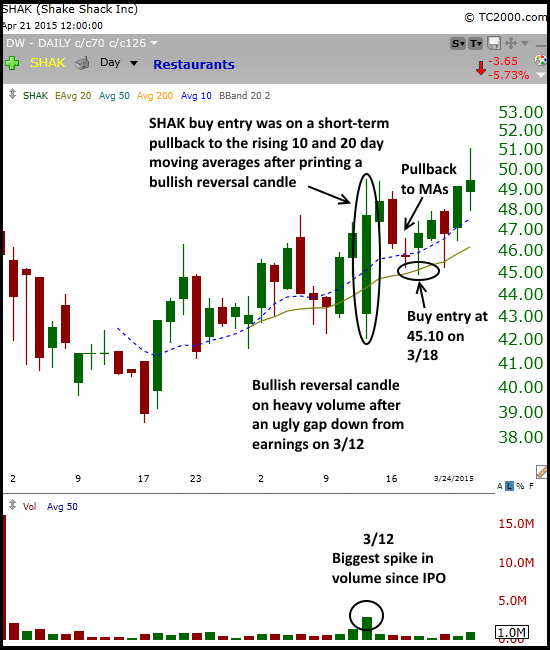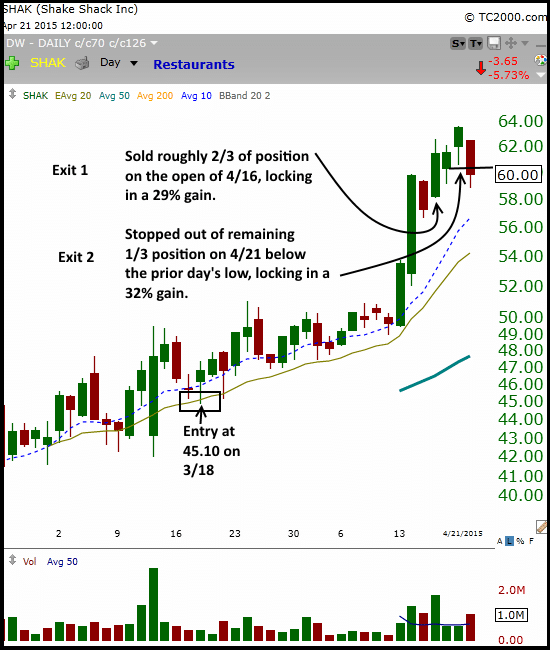 In trading, when to “take the money and run” on a winning trade depends on whether the original trade setup (the reason for entering the trade) was a quick, momentum-driven swing trade or a core trade that is based on a combination of strong technicals and a history of high earnings growth.
In trading, when to “take the money and run” on a winning trade depends on whether the original trade setup (the reason for entering the trade) was a quick, momentum-driven swing trade or a core trade that is based on a combination of strong technicals and a history of high earnings growth.
In the case of the 27% gain we recently locked in with the $NXPI trade, it was a core trade that we held for several months.
But this time around, we walk you through a purely momentum-driven setup instead, a trade that bagged Wagner Daily subscribers about a 30% share price gain in $SHAK over a 3-week period.
Continue reading to learn how this stock entered our radar, and why we bought and sold when we did…
Nightly Process For Daily Profits
Our daily stock scanning process is what keeps us in tune with the market, as the number of bullish chart patterns with leading stocks is one of the best indicators of the market’s true bullish momentum.
Each night, we run through several scans (using a combination of our online stock screener and good ol’ fashioned elbow grease) to search for stocks and ETFs with valid basing patterns, which are then added to our internal watchlist to monitor for low-risk entry points.
Specifically, there are 3 basic stock scans we run each and every night:
- Combo – Scan for leading stocks trading near 52-week highs, with top -ranked fundamental and technical ratings (strong earnings and revenue growth).
- Relative Strength – Scan for stocks that have made a strong advance over the past 6 to 12 months (a pure technical price scan with no fundamentals).
- IPO – Scan all IPOs within the past two years, with an emphasis on those within the past 6 months, for bullish chart patterns.
IPO + Strong Technicals = Explosive Action
Although not many of the trade setups we detail in our stock picking report are from the IPO scan, we always look forward to trading those stocks that eventually appear in the IPO scan because we have learned over the years that a combination of an IPO with a bullish chart pattern leads to nice breakouts with a high level of reliability.
About two months ago, $SHAK first appeared in our IPO scan and we first took notice of the price action as it set a higher low in late February, while holding the rising 10-day moving average.
On March 12, $SHAK opened about 10% lower due to a negative knee-jerk reaction to an earnings report, but buyers immediately stepped in and not only erased the intraday loss, but surprisingly pushed the stock to a positive closing price!
The result of that wild day of trading was the formation of a wide-ranged candlestick that closed above the prior day’s high on heavy volume.
This bullish reversal candle was certainly a clear buy signal; however, we patiently waited for a lower-risk buy entry to develop (because there wasn’t one at the time).
The Entry
After a 3-day pullback (on declining volume) to the 10-day moving average (a bullish sign), we decided to list $SHAK as a buy limit or buy stop order (whichever triggered first was the one we would take) in the March 18 issue of The Wagner Daily.
The daily chart below shows you how the chart looked when we bought the stock in mid-March:

On the morning of March 18, $SHAK “undercut” the prior day’s low and triggered our buy limit order at $45.10.
Once again, buyers arrived on price weakness, enabling the stock to reverse and rally to close in positive territory and above the prior day’s high.
As anticipated, price action followed through to the upside over the next few days, and quickly cleared the high of the wide-ranged reversal candle from March 12.
The Exit
After a few weeks of consolidation at the $50 level, $SHAK exploded higher over two sessions, allowing us to sell two-thirds of the position into strength, netting a 29% price gain on the open of April 16:

Although we sold on the open of April 16, it would have also been a good exit to have sold partial size on the prior day’s open or on the close of the second big up day as well.
After such a massive rally in a short period of time, we made a judgment call to significantly tighten the stop on our remaining shares, in order to protect the profits while still giving the setup a small bit of breathing room.
Just a few days later, $SHAK triggered our stop for the remaining one-third of the position, as it slipped below the prior day’s low (32% gain on the remaining shares sold that day).
How Long Do You Like To Hold?
For a pure swing trader, selling into strength of an explosive move like this is usually the way to go.
However, traders who are comfortable with being more patient with the action could alternatively have sold partial size (one-third to one-half of shares) into strength, then placed a very wide stop to hold the remaining shares longer.
Did you catch this winning trade too? If not, subscribe now to our nightly stock picking report to avoid missing out on our next big winner
